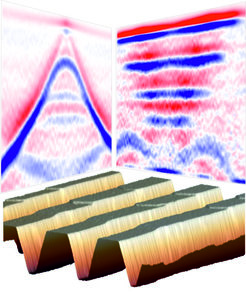A real-world “particle in a box”
Graphene is gapped at the smallest scales
For almost two decades, lots of excitement has surrounded graphene, regarding it as the future building block of electronic circuitry in the post-silicon era. However, since its discovery, graphene is still absent from our daily home appliances, mainly because of its metallic character, i.e., the lack of a sizeable bandgap in its electronic structure. In their most recent study published in Nature Communications, the Interface Analysis Group of the Max Planck Institute for Solid State Research in Stuttgart (MPI-FKF), together with their collaborators, have demonstrated that through one-dimensional (1D) confinement, a bandgap can be generated in graphene, whose size solely depends on the width of the so-called graphene nanoribbon (GNR). So far, the synthesis of gapped GNRs has mostly been carried out on metallic surfaces such as gold, thus making them impractical for technologically relevant applications. However, the team’s ability to grow high-quality, well-aligned and densely packed GNRs on a wafer scale, while using semiconducting SiC as a substrate, is a major accomplishment. This gives the opportunity to exploit the electronic properties of GNRs, hence allowing the realization of new transistor design concepts.

Graphene, in its pristine 2D form, is just a metallic system (albeit a very efficient one). When cut appropriately along its armchair edges into a ribbon shape, quantum confinement effects set in, giving rise to a width-dependent semiconducting gap. In their work, the scientists have successfully grown ultra-narrow armchair graphene nanoribbons (AGNRs) on the sidewalls of 6H-SiC mesa structures. The average bandgap value of the ribbons was found to be around 0.75 eV, which is desirable for defining an off state in logic circuitry.
“Beyond the development of a semiconducting bandgap in the AGNRs and their technological implications, our study also shows the fascinating behavior of the quantum world,” says Hrag Karakachian, PhD candidate at the Max Planck Institute for Solid State Research and first author of this study. The complete band structure of AGNRs was mapped for the first time using angle-resolved photoelectron spectroscopy (ARPES). It consists of well-resolved subbands, dispersing and non-dispersing along and across the ribbons respectively, which verifies earlier theoretical predictions and deepens our understanding of quantum confinement phenomena. Karakachian uses an analogy to illustrate these ideal 1D electronic features observed in the ARPES spectra (see figure). “Imagine a huge parking lot with a bunch of cars in it. The cars can easily move in all directions and past each other. This is analogous to free electrons moving (dispersing) in both x and y directions in a 2D graphene sheet. When the cars are forced into a narrow street on the other hand, their motion ceases to be free and becomes unidirectional. They are bound to move along the street but not across from it. The same principle applies to electrons in a 1D graphene nanoribbon: the electrons show a dispersion along the ribbons, but not across them. In quantum mechanics, this is a fascinating real-world “particle in a box”-type of behavior.”











